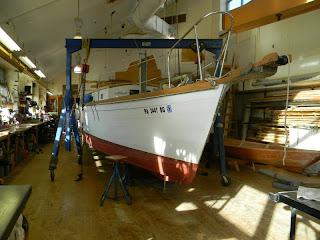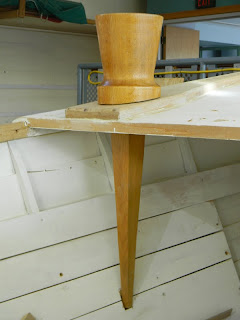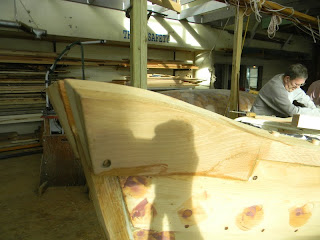It's difficult to ignore the newest arrival on the WoW shop floor. She is a 36' Francis Herreshoff designed Meadow Lark sharpie. While she has been at the ISM dock since October, and we have all gotten used to seeing her, she looks much bigger inside the shop. Water does, indeed, shrink boats.
Moving her the few yards from the dock into the shop was a multi-day adventure, beginning with running her up river to Riverton, NJ. to be hauled, and then trucked across the river and south, back to WoW. From there, tricky maneuvering by Jeff, Bruce, Newt, and a host of volunteers resulted in her reaching her present location, ready for repairs and rehabilitation.
 |
| 36' Herreshoff Meadow Lark sharpie is a real presence on the shop floor. |
Needless to say, the Meadow Lark will be a center of attention in the shop in the weeks ahead.
Sometimes you get to feel like the "shoemaker's children" working at WoW. Spending every hour working on building and fixing stuff for others, and never doing anything for yourself, but thanks to some considerable effort by staff and volunteers, we now have a brand new top on the long work counter on the south side of the shop. Having gotten 17 years of hard use out of the old one, replacement was certainly due.
 |
| New bench top -- shiny and smooth |
Work continued in earnest on the Beetle whaleboat replica. Newt and volunteers Lee, Steve, and John got well into the process of installing knees on each of the thwarts. This is a time consuming process (aren't they all) involving steam bending oak to almost a 90 degree curve, fitting it, and then scribing and cutting a cedar backer between the oak and the inner surface of the planks.
 |
| Newt clamps an oak knee in place |
 |
| Adjusting the knee for the perfect fit. |
 |
| Lee primes a thwart prior to bedding a knee. |
At both ends of the whaleboat, work was taking place as well. At the stern, Charles fitted the loggerhead through the lion's tongue, and beveled its bottom so the loggerhead would sit level with the waterline. Also, the ceiling was notched where the shaft of the loggerhead is inserted.
 |
| Cutting the bevel on the loggerhead base |
 |
| Loggerhead shaft let into ceiling. |
 |
| Loggerhead set into lion's tongue for strength and rigidity. |
On the other end, the bow chocks were finally bedded and fastened in place. These mighty oak chocks were used to hold the position of the harpoon line once the whale was harpooned.
 |
Bow chocks bedded, screwed, and bunged.
|
 |
| Bow chocks from the side. |
Meanwhile, the Marsh Cat was not being ignored. Bruce did his final fairing and sanding on the bottom in preparation for the application of a layer of fiberglas over the repaired bottom.
 |
| More fairing, more sanding. |